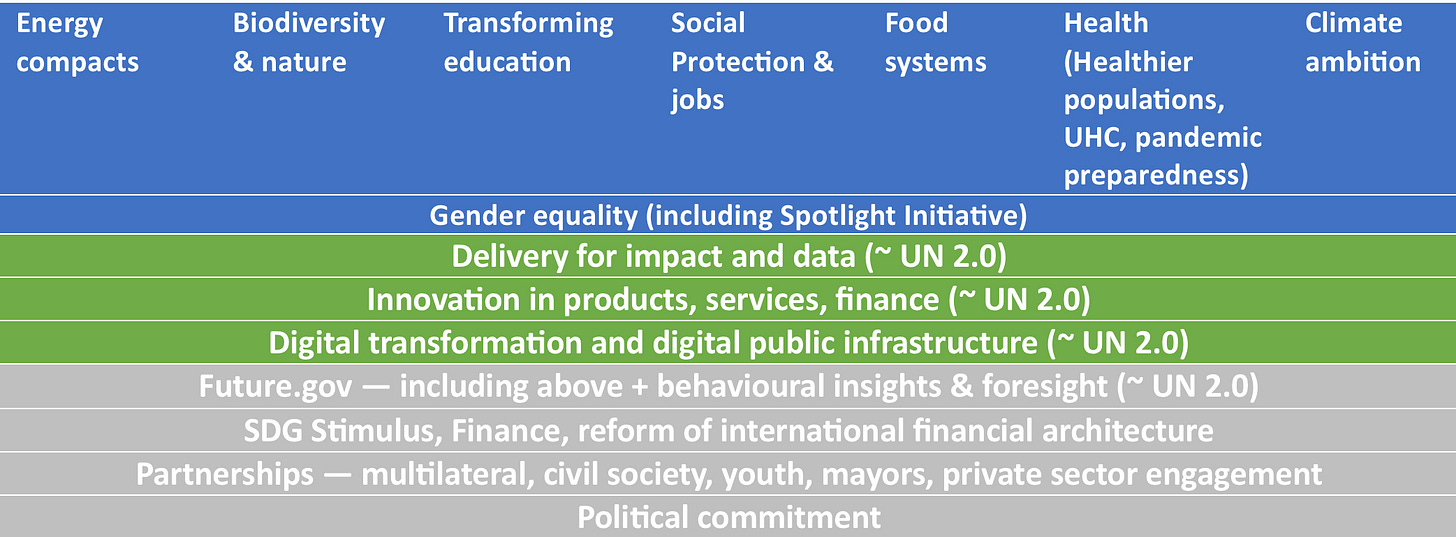Replace the SDGs with the GSDs
Halfway through Sustainable Development Goal (SDG) period, only 15% of the SDGs are on track. Universal Health Coverage, for example, is going at one-half the pace needed to reach the 2030 targets.
The SDGs are the world’s roadmap for development. Comprised of 17 goals and 169 targets, they were agreed by all countries in 2015 for attainment by 2030.
In some ways, the September 2023 SDG Summit, designed to take stock of progress in the first half of the SDG implementation period and plan for the second, was encouraging. There was strong political re-commitment by Heads of State and Government, as well as robust representation of women, youth, civil society, the private sector, mayors, and others.
There was a focus on a few “transitions” (see below), with coalitions built around them, plans for an ‘SDG stimulus’ of $500 billion per year and reform of the international financial system, and release of a paper called ‘UN 2.0’ on how UN agencies could better support countries with innovation, data, digitization, and more.
But no amount of planning will speed up the SDGs. People are not inspired by plans: they are inspired by results.
To speed up the SDGs, the world needs three things: implementation, implementation, implementation. In short, we need to replace the SDGs with the GSDs: Get Shit Done! (OK, I said ‘replace’, but I meant ‘refocus’ or ‘supplement’ the SDGs with the GSDs. And for diplomatic purposes, we can use the term ‘get stuff done.’)
How do we Get S*** Done?
Let’s focus first on what to stop doing. A moratorium on planning, conferences and photo ops for the next 7 years would speed up the SDGs.
In theory not doing something saves time and money that can be applied to execution. In practice it’s actually very hard to stop doing something, as anyone who has tried to end a meeting early knows.
The multilateral world is awash in plans, strategies, guidelines and resolutions. These suck the oxygen from the room and divert attention from execution. Rather than 90% planning and 10% execution, let’s flip the equation to 10% planing and 90% execution. I call for a moratorium on planning for the next 7 years, unless specifically designed to take stock of results, identify barriers to progress, and overcome them.
Second, people love to flit from conference to conference, spouting slogans as they go. I call for a moratorium on conferences for the next 7 years — unless specifically designed to take stock of results, identify barriers to progress, and overcome them. (Indeed, I propose such a GSD Summit at the end of this piece.)
Third, let’s stop doing photo ops. It doesn’t really matter who met with whom, with the possible exception of Heads of Agencies with Heads of State/Government. It doesn’t really matter what they plan to do. What matters most is what they are achieving. Meetings that take stock of results, identify barriers to progress, and overcome them are welcome.
(OK, I said ‘moratorium’ but I do not actually believe that plans, conferences and photo ops will stop — fewer and more results-focused ones would be just fine! And I also believe that diplomacy is a foundation for action.)
To get s*** done — and speed up the SDGs — what more should we do? Innovation, digitization, and delivery for impact, especially at the country level.
How can innovation speed up the SDGs? By focusing on the 100+ innovations that are now reaching 1 million people and scaling them to reach tens or even hundreds of millions of people. This requires the pull of demand from government and communities. The UN system is well positioned to help countries to scale innovations, but it needs to elevate the focus on innovation in the bureaucracy. I have gone into details in a recent blog, based on my own experience with the grand challenges innovation community and also on the UN side in WHO.
Digitization is a form of innovation, but it’s so important that it deserves its own focus. Moreover, it is dependent on digital public infrastructure. For example, WHO has recently published a Global Initiative on Digital Health, and supplementing this with supporting concrete innovations to scale would be welcome.
Perhaps most important to speed SDG progress is delivery for impact. When I first went to WHO, I thought the most important thing was indicators and targets. Then I came to realize that even more important was data systems in countries. My final realization was that what drives this system, and therefore most important of all, is the use of data to accelerate progress — delivery for impact. WHO has led the way in developing a coherent system of measuring outcomes (healthy life expectancy, triple billion, and SDG indicators), as well as measuring and managing outputs based on country priorities using delivery for impact to drive SDG outcomes. More detail can be found in this technical paper and blog.
Delivery for impact offers Member States a new approach to governance of UN agencies. Imagine as a board member being able to understand — and having a dashboard to track — what the agency is doing to speed up the SDGs. Imagine being able to hold UN agencies accountable for their contribution to SDG progress. This accountability itself would speed up the SDGs.
Underlying innovation, digitization, and delivery for impact, the most fundamental issue is people, because the SDGs are only as good as the people who solve them. In the UN system we have many diplo-crats. I have called for more diplo-preneuers. The sad fact is that entrepreneurially minded people, especially young people, often find themselves frustrated in the UN culture. This needs to change.
Better partnerships would also help speed up SDGs. There is fragmentation in the multilateral system and sometimes reluctance to partner. Governments get precisely the multilateral system they themselves incentivize. They could better incentivize partnerships among agencies, and with civil society and the private sector. Delivery for impact can serve as a common language for partnerships. These issues are honestly addressed in the recommendations of the 2023 progress report of the SDG 3 Global Action Plan, which are applicable across SDGs.
I am sometimes asked whether it is possible for the UN system to adopt to a GSD approach? I think it is possible, but requires leadership. My brother Dr Tedros provides an excellent example of leadership: he has created a strong Division of Data, Analytics, and Delivery for Impact and launched an Innovation Hub, mRNA Vaccine Technology Transfer Hub, Global Initiative on Digital Health, and Health Impact Investment Platform. Under Dr Tedros’ leadership, WHO is well positioned for the GSDs, but these approaches now need to be taken to scale. Similarly, as I detailed in my last blog, several UN agencies have created platforms to scale innovation, but these need to be elevated and strengthened.
In calling for this GSD approach, I want to acknowledge the leadership, hard work, and results of UN agencies. I just think agencies have a tendency to keep doing what they are doing, and we all need to allocate more effort to what to do differently to speed up the SDGs.
Finally, a caveat: I do not believe that the world’s deepening geopolitical divisions will be healed by the GSD approach, although it is possible that the technical work of the UN and countries will be better insulated. And in the end, I have to believe that prosperity is more enticing than depravity.
A GSD Summit?
Of all the opportunities for UN agencies and countries to pivot to the GSD approach, perhaps the most promising is the September 2024 UN Summit of the Future, co-facilitated by Germany and Namibia. The build-up to the Summit (which has already begun), and the Summit itself, provide a prime opportunity to refocus the SDGs on the GSD approach.
Isn’t it contradictory to end a piece arguing for a moratorium on planning, conferences, and photo ops with a section on a Summit? No — if the Summit takes stock of results, identifies barriers to progress, and overcomes them. And in truth this Summit is going to happen anyway. The only question is whether it will be focused on the GSDs.
Below I propose a framework for the Summit, based on the one developed for the SDG Summit co-facilitated by Ireland and Qatar in 2023, and further shaped by the considerations above. In blue is content: the transitions proposed at the SDG Summit plus health and climate which were addressed in their own right at the UN General Assembly in September 2023. In green are the main GSD methods: delivery for impact, innovation, and digitalization — all components of UN 2.0. In grey are the foundations: political commitment, partnerships, finance, and Future.gov (an initiative from the SDG Summit to reshape government services).
The key question: ‘What will be different in the next seven years compared to the first half of the SDG period?’ The answer is found in green: delivery for impact, innovation, and digitalization — this is the “engine room” to drive SDG progress. Elevating these approaches and showing how they drive SDGs should be the focus of the Summit. The rule should be that 80% of the airtime is taken up by concrete examples that could scale. This was achieved in the middle of the digital transformation event at the 2023 SDG Summit, which showcased one specific innovation for each SDG, and should be the model for the Summit of the Future.
I call upon the Governments of Germany and Namibia, all UN Member States, the Executive Office of the Secretary General, and Heads of UN agencies to refocus the SDGs on the GSD approach. Otherwise, we will find ourselves in seven years wringing our hands about the lack of progress.




"People are not inspired by plans: they are inspired by results." THIS is inspiring as is a refocus on GSD. I also like first looking to what should be eliminated. A seven-year moratorium on planning meetings? That deserves more inquiry. Sign my up to the GSDs!
Peter, you always get straight to the heart of the problem. I learned the term 'pilotitis' from you and I can confirm that as I am on a jet liner recrossing the Atlantic after attending the RHSC Membership Meetings in Accra, Ghana there is still too much talking and planning and not enough of GSD. Time, money and resources continue to be misdirected due to redundancy and inefficiencies. Many resources are wasted bulking up the mired middle. Enough wringing of hands and confusing these gestures for action. Action happens on the ground, is measurable, but also, I might add, much more economical than the current bureaucratic approaches that lead to same old same old results. Positive impact requires a measure of risk. The private sector, by this I mean primarily SMEs, have solutions to a complexity of solutions that should be exploited. We SMEs have taken significant risks in order to continue to exist and position ourselves for sustainability. In fact, SMEs fuel national economies, so why not the achievement of the SDGs. Let's GSD.